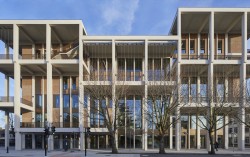This week on the Offsite Hub Blog, Jenny Burridge, Head of Structural Engineering, The Concrete Centre talks us through the use of long-lasting precast concrete as a prefect offsite construction for tall buildings design.
The use of precast concrete elements is a well-established construction method and provides solutions with a great variety of use, location, shape and finish. Taking the concreting work into the factory provides benefits of tight tolerances, excellent finishes not reliant on weather and provides a safer location for most of the work.
The core of a tall building is arguably the most fundamental and important element under consideration during the design process. For most tall structures, the core forms the main backbone of the building and plays a significant role in carrying a large proportion of vertical loading and, frequently, the majority of lateral loading.
Many offsite tall buildings use a slip form core as the stability system as the slip forming can be done before any other superstructure work proceeds and is sometimes started as a top down system where the core is supported by temporary piles while the basement is excavated below. Cores can also be formed from volumetric precast concrete core elements bolted together to form a full core. These are normally half a storey height tall and sized to be able to be transported. These were used on the Kingston University Townhouse project, which is a predominately precast building.
Precast cores can be formed from crosswall elements or from twin wall elements. Crosswall elements are flat panels of precast concrete connected using ties at the corners and joints. Twin wall elements are formed from two skins of precast concrete fixed apart with a latticework of reinforcement. The space between the skins of precast concrete is filled with in situ concrete making a hybrid concrete solution. Ties between the panels of twin wall and connections to the horizontal elements are made using reinforcement through the in-situ section.
Precast concrete has inherent fire-resistance characteristics, with the concrete cover providing insulation to the reinforcement. Fire-resistance periods of two hours can be easily achieved, which is the typical requirement for tall buildings. As a non-combustible structural material, concrete does not burn and can be used to meet and exceed stringent requirements for the fire safety of people and property.
Another aspect of design that is becoming ever more urgent is sustainability, in particular the embodied carbon in buildings. Tall buildings are inherently higher in embodied carbon per square metre of usable space than low rise buildings whether these are built on-site or offsite. However, this can be offset to a certain extent by the reduction in travel distances for high-density urban spaces. The design of the concrete mix can reduce the embodied carbon of the structure but needs to be considered together with the other aspects of the design. The concrete mix used for precast concrete is typically higher in Portland cement than that for in-situ concrete due to the need to demould quickly from the formwork in the factory. This leads to a higher embodied carbon for the mix, but the element sizes can be smaller due to factory casting, so overall precast concrete is a low carbon solution.
Early design and contractor involvement is key to producing safe, durable, resilient tall buildings designed for manufacture and assembly, taking the work into the factory and off the construction site. Only by working together can the optimum solution be reached. Tall buildings are a vital part of our city landscape and should be designed to last many years so that the full benefit can be realised for us and future generations.
The Concrete Centre has hosted a webinar, where members of the Town House, Kingston project team discuss the construction methods used. Watch at: www.concretecentre.com
Image: 1 Kingston University Townhouse. Courtesy PCE Ltd









